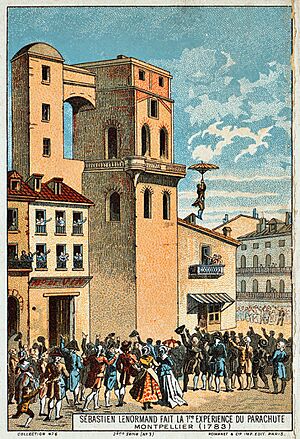Louis-Sébastien Lenormand facts for kids
Louis-Sébastien Lenormand (born May 25, 1757 – died April 4, 1837) was a French chemist, physicist, and inventor. He is known as a very important person in the early history of parachuting.
Who Was Louis-Sébastien Lenormand?
Louis-Sébastien Lenormand was born in Montpellier, France, on May 25, 1757. His father was a clockmaker. When he was a young man, from 1775 to 1780, Louis-Sébastien studied physics and chemistry in Paris. He learned from famous scientists like Lavoisier and Berthollet.
After his studies, he went back to his hometown. He worked in his father's clock shop. But he also spent a lot of time learning new things and doing his own experiments. He became very interested in parachutes. This idea came to him after he saw a Thai performer use a parasol to help with balance.
Before he tried jumping himself, Lenormand tested his parachute ideas. He used animals to make sure his designs would work safely.
The First Parachute Jump
Many people believe Louis-Sébastien Lenormand was the first person to make a witnessed jump with a parachute. He also created the word parachute. He combined the Latin word para, which means "against" or "to avoid," with the French word chute, meaning "fall." So, "parachute" literally means "against a fall."
Lenormand first tried jumping from a tree using modified umbrellas. He then made his invention better. On December 26, 1783, he made a public jump. He jumped from the tower of the Montpellier observatory. A large crowd watched him, including Joseph Montgolfier, who was famous for hot air balloons. Lenormand used a parachute that was about 14 foot (4.3 m) wide and had a strong wooden frame.
Lenormand's main idea for the parachute was to help people. He wanted it to be a way for people to escape safely from burning buildings. Later, other people continued his work. André-Jacques Garnerin made the first parachute jump from a hot air balloon in 1797. His wife, Jeanne Geneviève Labrosse, made a similar jump two years later.
A Career in Technology
After his famous parachute jump, Lenormand decided to focus on a new field. He wanted to create the science of "pure technology." He even became a monk for a while. This allowed him to continue his studies in science.
Later, he moved to Albi and taught technology at a new college. In 1803, he moved to Paris. There, he started publishing articles in technology journals. He also got patents for several inventions. These included a paddle boat, a special clock for the Paris Opera, and a new public lighting system.
Lenormand became very involved in publishing. He started magazines like Les annales de l’industrie nationale et étrangère (The Annals of National and Foreign Industry). He also wrote a huge, twenty-volume book called Le Dictionnaire technologique (The Technologic Dictionary). This book was published from 1822 until he died in 1837. He also wrote helpful guides on many different topics, from food to making books.
In 1830, Lenormand returned to Castres. He went back to his religious life. He passed away on April 4, 1837, at 79 years old. Even though he was a pioneer in technology, his death certificate listed him as a "professor of theology." This shows how new the word "technology" was at the time.


